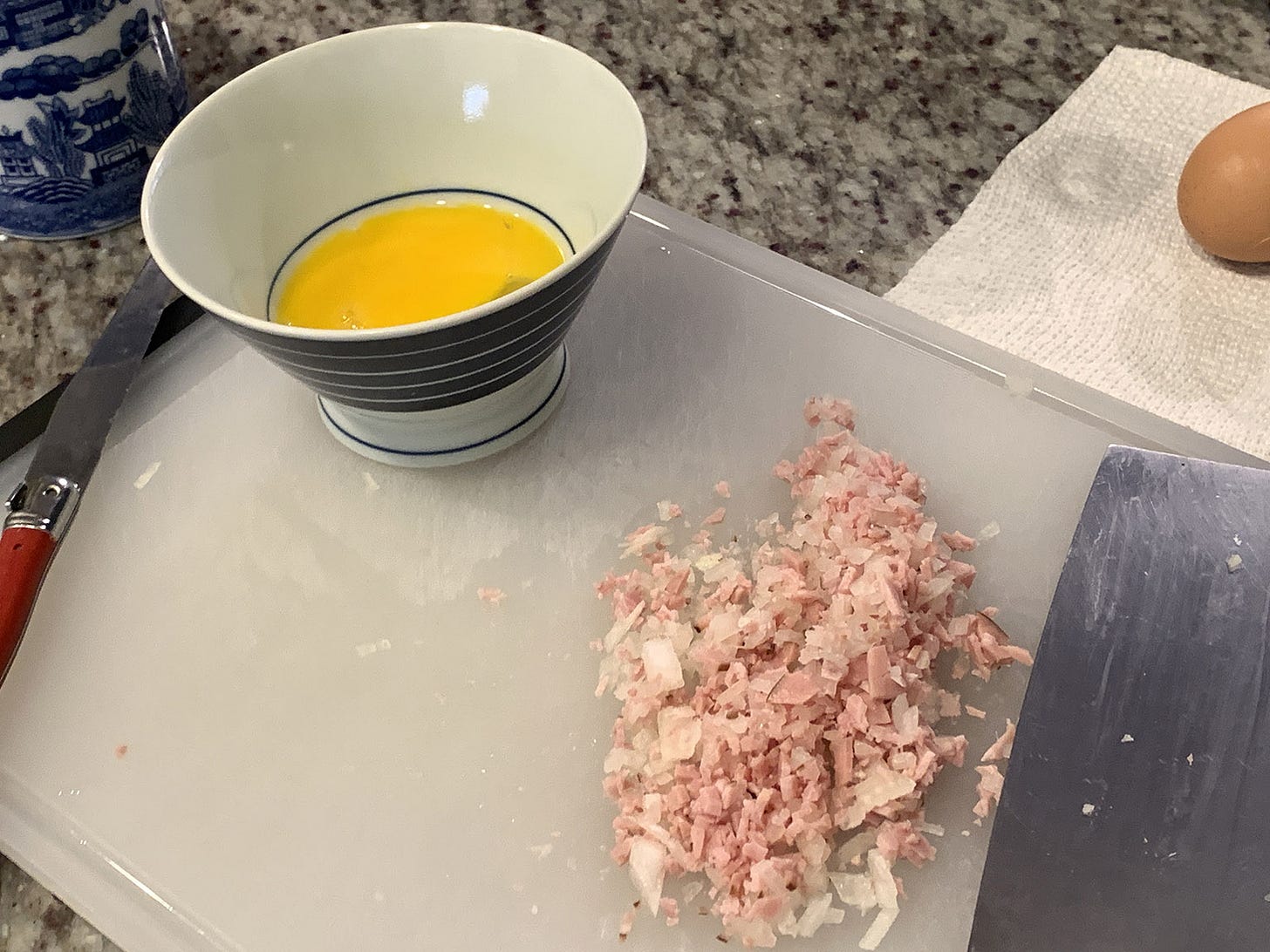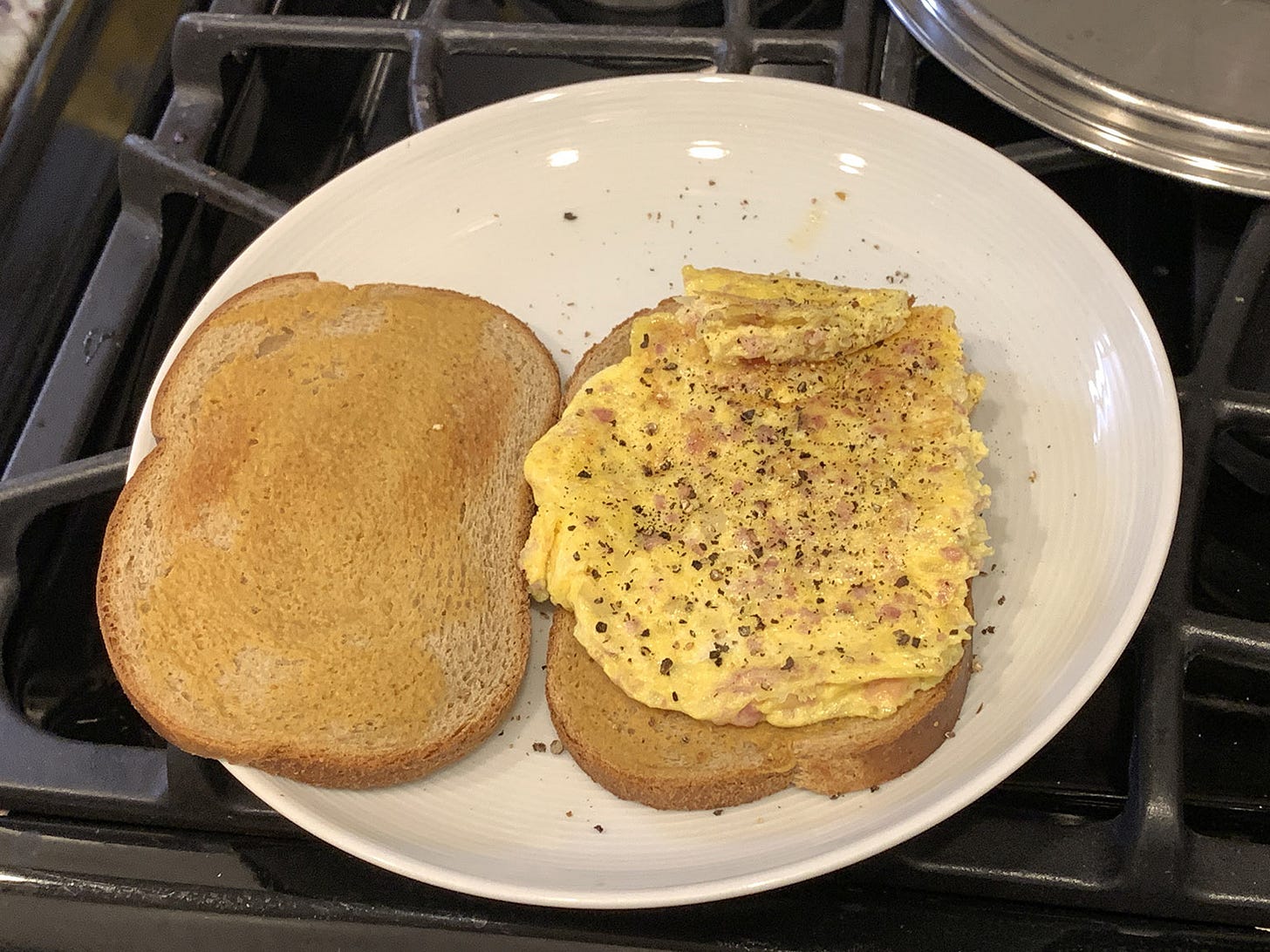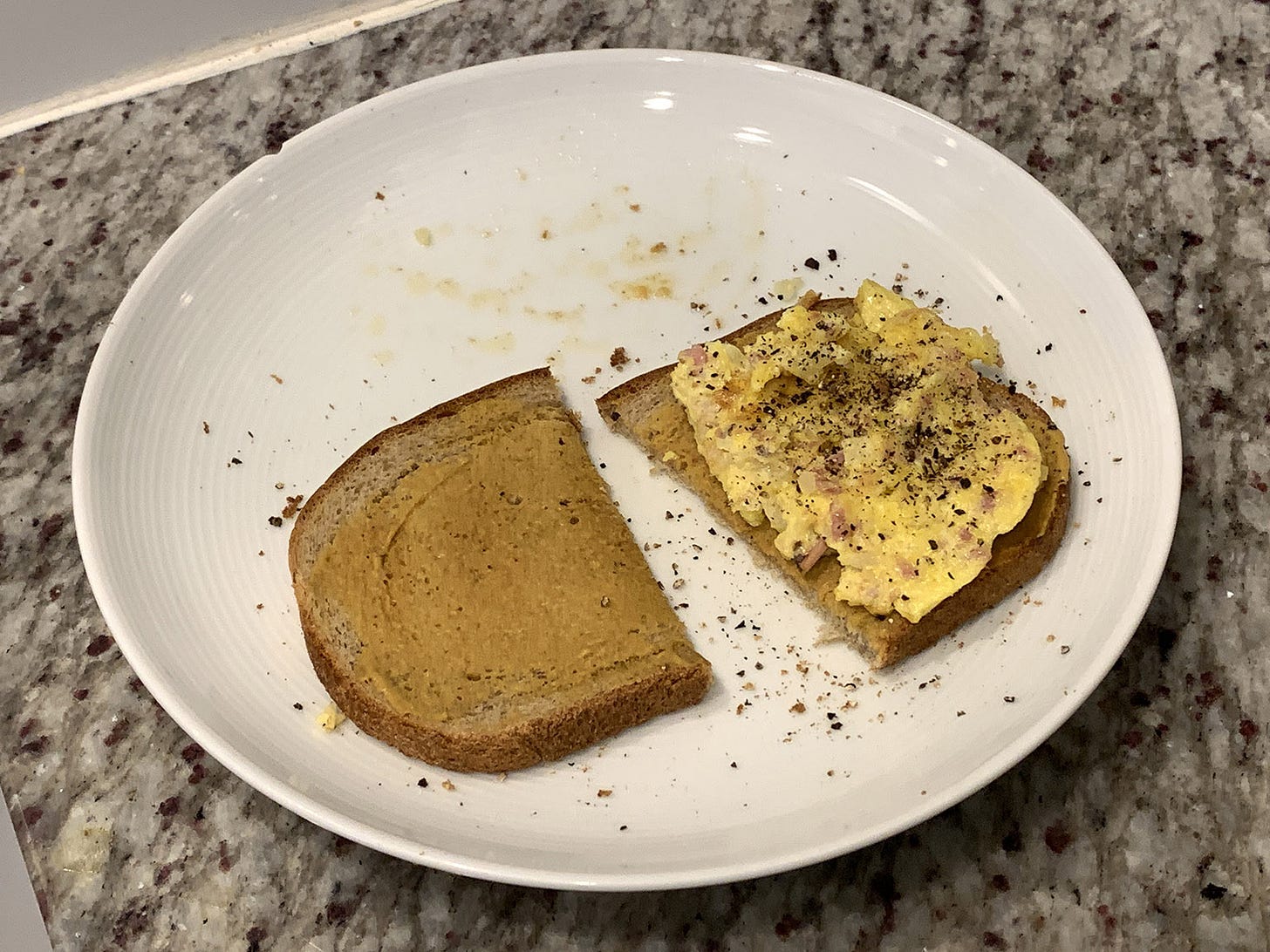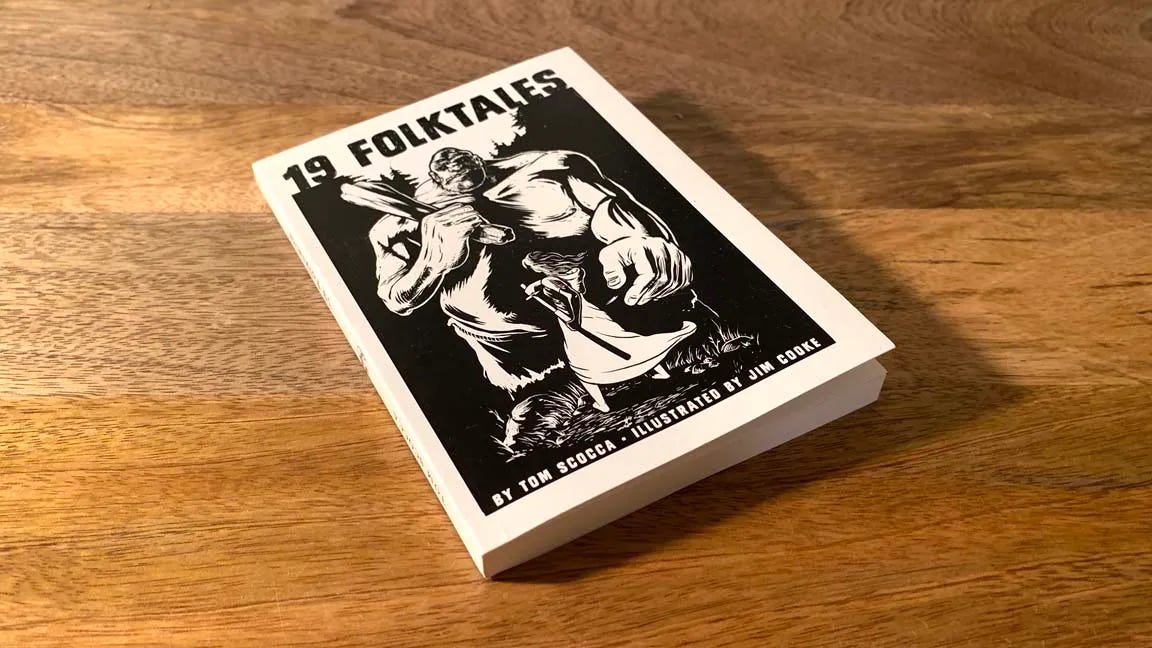SANDWICH REALIZATIONS DEP'T.
Making the Western Sandwich of 1924
I WAS ALL out of ideas for what to eat today when I remembered yesterday's recipe for the Western Sandwich, as provided by Andrew Nichols, M. D., in 1924's The Home-Maker's Cookbook, Containing True and Tried Recipes, collected and published by the Ladies of the Women’s Missionary Society Congregational Church, Tewksbury, Massachusetts. Archaic sandwiches don't get much easier than this:
Beat one egg. Add small amount of chopped ham and onion. Mix together and turn into a small buttered frying pan; brown on both sides, then place between slices of bread, spread with thin layer of mustard, salt and pepper to taste.
No arcane or cryptically named ingredients, nothing that had to be boiled and run through a meat chopper. A scrambled egg with stuff mixed into it, like I'd learned to make over a campfire in Boy Scouts. Or, since it didn't get stirred in the pan, an unorthodoxly sequenced omelet.
Everything was in place for the Western Sandwich. We had two eggs sitting out on the counter in a bowl, where they'd been since the weekend, when we'd discovered that one of their carton-mates had smashed open in transit and gummed up the others. Eggs don't need to be refrigerated, except American supermarket eggs do need to be refrigerated, especially if you've washed the protective coating off them. I think that's the lore, anyway. These eggs were fine, surely; it was just that the surety would keep on being a little less sure with each passing day until we used them up. I cracked one into another bowl.
In the fridge was a pack of deli ham, unopened, which had been sitting in reserve in the event some morning arrived when the kids needed lunch packed and we were out of leftovers. It was uncured ham, so it couldn't stand by indefinitely. I checked the use-or-freeze-by date: February 23. Across a century, Andrew Nichols, M.D., had called for it just in time.
What was a "small amount" of ham? I tore off half a slice and chopped it. The cat is allowed to perch on the kitchen pass-through as long as she doesn't venture onto the counter, and now she hunched over toward me like Snoopy impersonating a vulture. The cat's grasp of the concept of rules is tenuous at best, and the smell of deli meats or cheeses will usually push it right out of her head. She tried to make her move while I was starting some butter melting in a nonstick skillet, and I had to grab the squirt gun off the counter and chase her away.
The fridge had half an onion, too, in a Ziploc. I hadn't thought through the sequencing, so to avoid getting ham traces on the unused part of the onion, I used a clean steak knife to cut off a wedge. I thought I was getting a small enough wedge, but by the time I'd minced it, there was clearly too much onion for the ham. I got the other half-slice of ham and chopped it. Now there was too much ham for the onion. I whittled another bit off the onion. Finally, the balance looked right; there just wasn't going to be enough egg to go with it. I cracked the second egg to join the first, then stirred in the ham and onion. The recipe didn't specify what kind of bread, or whether or not to toast it, but two slices of rye bread went into the toaster.
If I were telling Andrew Nichols, M.D., how to make the sandwich, I would have told him to fry up the onion and ham on their own first, so the onion could soften a little and the ham could brown up, and then pour in the egg. But I wasn't making my personal version of an egg sandwich with ham and onion, I was making the 1924 Western Sandwich. Into the pan went the whole mixture.
I'd used a medium pan, rather than a small one, so the double portion of egg spread out too far. This particular nonstick pan came with incredibly fussy instructions, warning that even nylon implements were too harsh for its tender surface, so I used a regular silicone spatula to push in the edges until the mass of egg looked roughly the size of a slice of rye bread. The insides were going to take a while to set up.
One point on which I'd planned to break company with Andrew Nichols, M.D., was on the browning of the eggs, which seemed crude and excessive. But I realized that part was out of my control. I'm not a wrist-flip cook, even with items less blocky and awkward than the Western Sandwich innards were shaping up to be, and with the nylon turner spatula off limits, the egg mass wasn't going to get flipped until I was sure I could get the job done with silicone spatulas. By the time I did get it inverted, there were golden-brown patches all over the cooked side.
While the second side finished, I squeezed some regular yellow mustard on the rye toast and spread it around as thinly as I could manage, while the toast eagerly soaked it up. Through some quirk of color interaction, the mustard looked more brown than yellow against the beige surface of the rye. I eyeballed the egg product in the pan, cut it down with a spatula to more precisely fit the sandwich, and laid it out on the toast, with the excess set off on the side of the plate. It had cooked in salted butter, so I just ground some pepper over it.
I'd hoped that Andrew Nichols, M.D., had had some real insight into the value of the mustard, that there might be some egg-ham-mustard interaction I'd never had the chance to appreciate before, the way the Old Town Bar puts mustard in its grilled-cheese-and-bacon sandwich. But when I bit into it, it just tasted like an egg sandwich with mustard on it. Maybe the mustard was a little loud, relative to the egg. I opened up the sandwich and added some salt.
When it was gone, I toasted another slice of rye and made a half-sandwich out of the extra part.
EASY LISTENING DEP'T.
SANDWICH RECIPES DEP’T.
WE PRESENT INSTRUCTIONS for the assembly of sandwiches from Modern Priscilla Cook Book; One Thousand Recipes Tested And Proved At The Priscilla Proving Plant, published in 1924, by The Priscilla Publishing Company, now in the Public Domain and available at archive.org for the delectation of all.
SANDWICHES
Sandwiches usually form an important part of the lunch box or picnic meal. Fillings should be selected which give adequate food value and sufficient variety to appeal to the appetite. The keeping quality is also a consideration. Vegetables that wilt quickly and semiliquid mixtures that soak into the bread should be avoided.
A whole-meal sandwich should be sufficiently hearty to make a whole course at luncheon or supper. Salad sandwiches, meat sandwiches served with hot gravy, and club sandwiches fall into this class. Sandwiches made from toast instead of plain bread are often used.
For the afternoon tea sandwich, slices of bread with the crust removed and of wafer-like thinness are essential. Fancy cutters have their place here. The open sandwich, a single slice of bread spread with filling and attractively garnished, may be used for variety.
The canape is really an open sandwich served as the first course at dinner. Highly seasoned fillings are used and the bread is usually sauted in butter or toasted.
APPLE SANDWICHES
2 ripe apples
2 stalks celery
1 sweet pepper
Chop ingredients fine, and mix together with a little mayonnaise dressing. Spread between thin slices of buttered bread and garnish with a sprig of watercress. 6 sandwiches.
CREAM CHEESE AND NUT SANDWICHES
3 ounces chopped nuts
3 cream cheeses
3 tablespoons French Dressing
Mix nuts, cheeses, and dressing and spread between thin slices of bread. 18 sandwiches.
EGG AND WATERCRESS SANDWICHES
4 hard-cooked eggs
1 bunch watercress
1/2 cup mayonnaise
Salt, pepper, paprika
Chop egg and cress very fine, mix to a paste with mayonnaise, and season to taste. Spread on thin buttered slices of entire wheat bread. Cut any shape desired. 9 sandwiches.
GUAVA SANDWICHES
3/4 cup cream cheese
2 tablespoons cream
1/4 cup salted almonds, chopped
Guava jelly
Mash cheese, soften with cream, and add chopped nuts. Spread on thinly sliced bread, cover with a thin layer of Guava jelly, and make into sandwiches. Cut fancy shapes from thin slices of the jelly and place one on each sandwich. 8 sandwiches.
If you decide to prepare and attempt to enjoy a sandwich inspired by this offering, be sure to send a picture to indignity@indignity.net.
MARKETING DEP'T.
Flaming Hydra is right now!
EACH WEEKDAY, SUBSCRIBERS to Flaming Hydra now receive a newsletter featuring pieces written by two different members of the Flaming Hydra cooperative, an all-star collection of independent writers, on a rotating basis. Everyone chips in their bit, and the readers get a steady diet of items. And if the readers keep on subscribing, the writers keep on chipping in, and the whole thing moves toward being a self-sustaining publication.
The second printing of 19 FOLK TALES is now available for gift-giving and personal perusal! Huddle up against the cold with a cozy collection of stories, each of which is concise enough to read within the snowy part of a wintry-mix storm.
HMM WEEKLY MINI-ZINE, Subject: GAME SHOW, Joe MacLeod’s account of his Total Experience of a Journey Into Television, expanded from the original published account found here at Hmm Daily. The special MINI ZINE features other viewpoints related to an appearance on, at, and inside the teevee game show Who Wants to Be A Millionaire, available for purchase at SHOPULA.
INDIGNITY is a general-interest publication for a discerning and self-selected audience. We appreciate and depend on your support!












